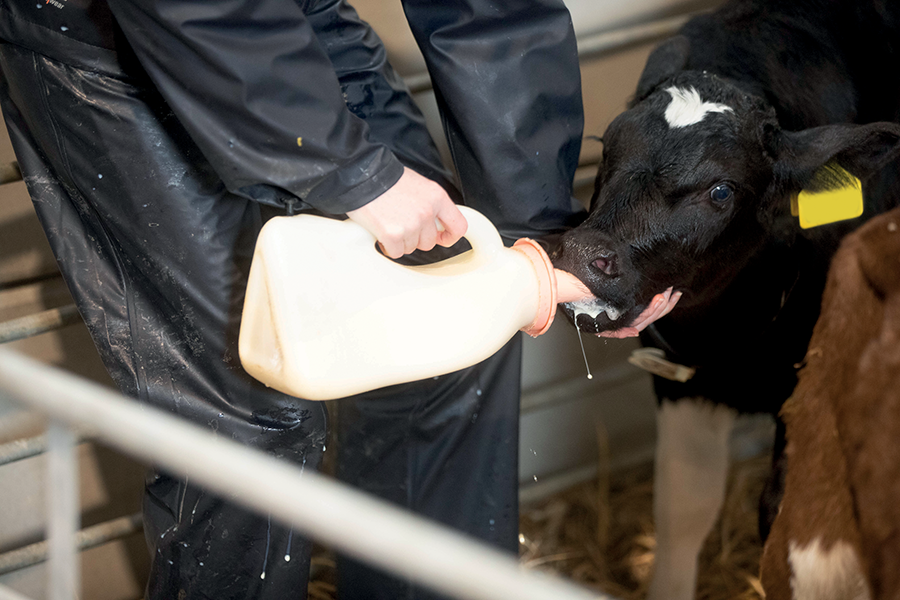Colostrum guidelines at calving for short and long-term payoffs
4th January 2024
Emily Hall, livestock farmer and product manager for Nettex discusses key colostrum targets and what to look for in a colostrum powder when supplementation is needed.

Full of protein, fat and antibodies, maternal colostrum delivers newborn calves with a super-shot of energy and immunity support that carry both short and long-term benefits, says Emily Hall.
“The thick, creamy consistency of colostrum is from its high fat content. This provides calves with a rich energy source which allows them to maintain their body temperature and bodily functions,” she says.
Antibodies from the dam’s immune system uplift a calf’s immune response in the first weeks of life as its own immune system starts to develop. Known as passive transfer, this requires maternal colostrum to contain an adequate level of IgG antibodies that are fed quickly after birth and in the right quantities.
“For successful passive transfer of IgG antibodies, maternal colostrum quality needs to be a minimum of 50g/l IgG, which equates to 22 Brix when measured with a refractometer,” explains Emily.
Multiple maternal colostrum feedings within the first 12 hours of life are critical to ensure IgG molecules are absorbed by the small intestine and delivered to the blood supply. Per industry guidelines, calves should receive a minimum of three litres within the first two hours of life and additional 3–4 litres within 6–12 hours of birth – for a total of 6–7 litres of high quality colostrum within its first 12 hours of life.
“To fully capture the immune response benefits, the right amount of high-quality maternal colostrum must be fed as soon as possible post-birth,” says Emily. “Doing so will not only boost the immune response in those critical first weeks of life, but it will also set calves up to have a healthier lifetime.”
What to look for in a colostrum powder
When a dam’s colostrum is low in quality or low in quantity, supplementation is required. To best support calves with protective antibodies from the farm where it was born, Emily recommends maternal dam colostrum from a cow on the same farm.
When it is not available or is going to take too long to thaw out for the first feed, she recommends supplementing with a high quality, full fat colostrum powder like Nettex’s Calf Colostrum Gold. Sourced exclusively from TB and EBL free herds in the UK, the production process for Calf Colostrum Gold makes it a close substitute for maternal dam colostrum.
“Raw colostrum collected from high health status farms in the UK is frozen at the source and then dried using a unique process preserving all of the components of natural colostrum. This produces a unique, high quality colostrum product high in protein, colostral fat and growth factors as well as being tested for both safety and efficacy,” explains Emily.
This process also results in a colostrum powder that is consistent, easy to mix and easy to use.
“Easy to mix, Calf Colostrum Gold has a similar consistency and colour to maternal dam colostrum. This is the next best option to maternal dam colostrum and is a great tool to have on hand for when supplementation is required.”
Opportunities for improved colostrum management
There is a huge opportunity for both dairy and beef farmers to improve the short and long-term health and performance of their herds with better colostrum management, according to Emily.
Industry research has found 61% of dairy calves and 20% of suckler calves left to suckle the dam for colostrum did not receive enough IgG antibodies for successful passive transfer. Data also shows that 20–25% of calves don’t feed from the dam within the first eight hours of life and few consume enough colostrum within the peak absorption window.
“The combination of nutrients and antibodies in maternal colostrum will benefit the lifetime health and performance in calves when received in the right quantities and right quality post-birth,” concludes Emily. “Many cattle farms will benefit from stepping up colostrum management protocols to test colostrum quality with a refractometer and to feed colostrum with a bottle rather than relying on calves to suckle the dam to ensure these critical targets are met.”
For more livestock news click here



